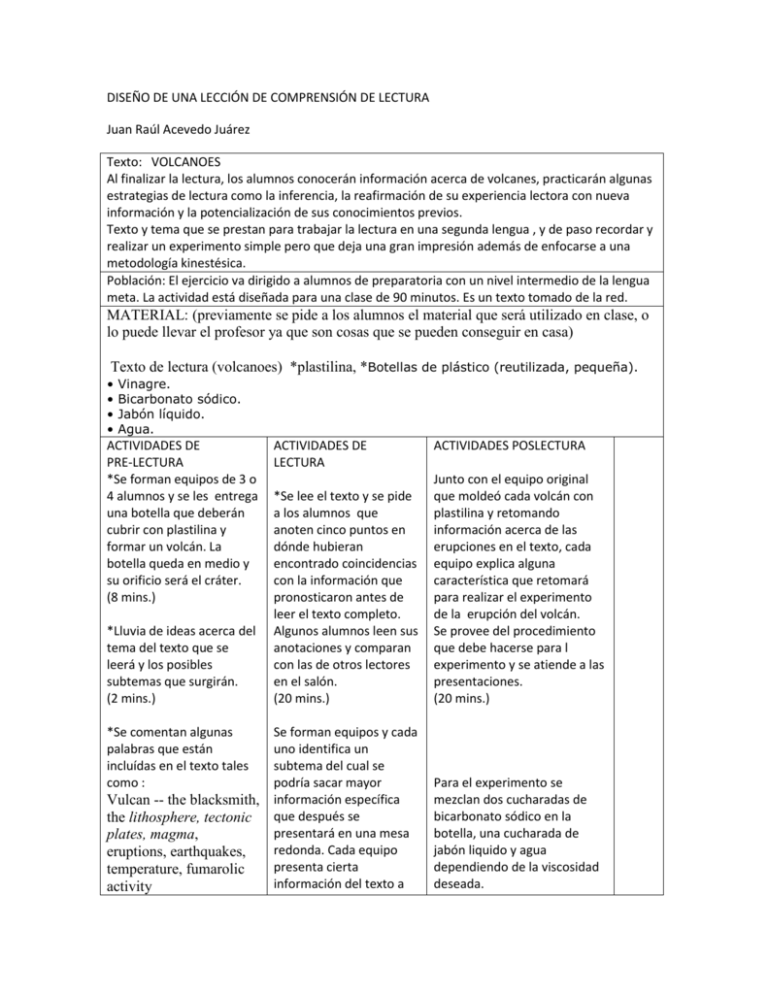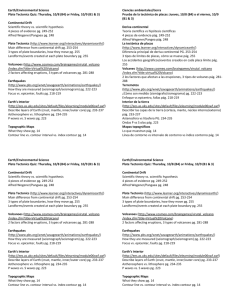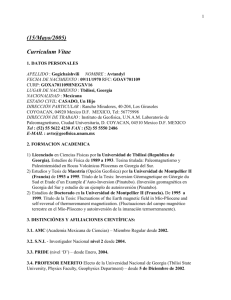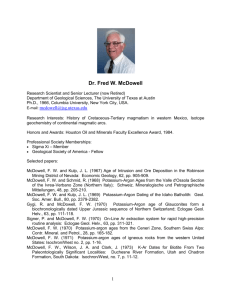disenoleccion-volcanoes
advertisement

DISEÑO DE UNA LECCIÓN DE COMPRENSIÓN DE LECTURA Juan Raúl Acevedo Juárez Texto: VOLCANOES Al finalizar la lectura, los alumnos conocerán información acerca de volcanes, practicarán algunas estrategias de lectura como la inferencia, la reafirmación de su experiencia lectora con nueva información y la potencialización de sus conocimientos previos. Texto y tema que se prestan para trabajar la lectura en una segunda lengua , y de paso recordar y realizar un experimento simple pero que deja una gran impresión además de enfocarse a una metodología kinestésica. Población: El ejercicio va dirigido a alumnos de preparatoria con un nivel intermedio de la lengua meta. La actividad está diseñada para una clase de 90 minutos. Es un texto tomado de la red. MATERIAL: (previamente se pide a los alumnos el material que será utilizado en clase, o lo puede llevar el profesor ya que son cosas que se pueden conseguir en casa) Texto de lectura (volcanoes) *plastilina, *Botellas de plástico (reutilizada, pequeña). • • • • Vinagre. Bicarbonato sódico. Jabón líquido. Agua. ACTIVIDADES DE PRE-LECTURA *Se forman equipos de 3 o 4 alumnos y se les entrega una botella que deberán cubrir con plastilina y formar un volcán. La botella queda en medio y su orificio será el cráter. (8 mins.) *Lluvia de ideas acerca del tema del texto que se leerá y los posibles subtemas que surgirán. (2 mins.) *Se comentan algunas palabras que están incluídas en el texto tales como : Vulcan -- the blacksmith, the lithosphere, tectonic plates, magma, eruptions, earthquakes, temperature, fumarolic activity ACTIVIDADES DE LECTURA ACTIVIDADES POSLECTURA *Se lee el texto y se pide a los alumnos que anoten cinco puntos en dónde hubieran encontrado coincidencias con la información que pronosticaron antes de leer el texto completo. Algunos alumnos leen sus anotaciones y comparan con las de otros lectores en el salón. (20 mins.) Junto con el equipo original que moldeó cada volcán con plastilina y retomando información acerca de las erupciones en el texto, cada equipo explica alguna característica que retomará para realizar el experimento de la erupción del volcán. Se provee del procedimiento que debe hacerse para l experimento y se atiende a las presentaciones. (20 mins.) Se forman equipos y cada uno identifica un subtema del cual se podría sacar mayor información específica que después se presentará en una mesa redonda. Cada equipo presenta cierta información del texto a Para el experimento se mezclan dos cucharadas de bicarbonato sódico en la botella, una cucharada de jabón liquido y agua dependiendo de la viscosidad deseada. y se interpretan y pid información acerca de lo que saben los alumnos, de esta manera acercándose a la información del texto y adelantándose a lo que probablemente incluya el texto. (5 mins.) partir de una sola palabra o concepto que tiene que ver con el volcán que formaron. Ejemplos de ello pueden ser que se les pida que le hagan una grieta, o que expliquen las partes de un volcán, o daños que puede causar. Las conclusiones se explican a todos al frente del salón. (30 mins.) El toque final es añadir un chorro de vinagre el cuál provocará la reacción. Se pide a cada alumno que escoja una oración en particular en la cual señale elementos de cohesión que hayan encontrado y que parezcan ejemplificativas. Se escriben algunas en el pizarrón. (5 mins.) Volcanoes The word "volcano" comes from the little island of Vulcano in the Mediterranean Sea off Sicily. Centuries ago, the people living in this area believed that Vulcano was the chimney of the forge of Vulcan -- the blacksmith of the Roman gods. They thought that the hot lava fragments and clouds of dust erupting form Vulcano came from Vulcan's forge as he beat out thunderbolts for Jupiter, king of the gods, and weapons for Mars, the god of war. In Polynesia the people attributed eruptive activity to the beautiful but wrathful Pele, Goddess of Volcanoes, whenever she was angry or spiteful. Today we know that volcanic eruptions are not super-natural but can be studied and interpreted by scientists. Where do volcanoes occur? Volcanic eruptions occur only in certain places and do not occur randomly. That's because the Earth's outermost shell -- the lithosphere -- is broken into a series of slabs known as lithospheric or tectonic plates. These plates are rigid, but they float on the hotter, softer layer in the Earth's mantle. There are 16 major plates. As the plates move about, they spread apart, collide, or slide past each other. Volcanoes occur most frequently at plate boundaries. Deep within the Earth it is so hot that some rocks slowly melt and become a thick flowing substance called magma. Because it is lighter than the solid rock around it, magma rises and collects in magma chambers. Eventually some of the magma pushes through vents and fissures in the Earth's surface. A volcanic eruption occurs! Magma that has erupted is called lava. Some volcanic eruptions are explosive and other are not. How explosive an eruption is depends on how runny or sticky the magma is. If magma is thin and runny, gases can escape easily from it. When this type of magma erupts, it flows out of the volcano. Lava flows rarely kill people because they move slowly enough for people to get out of their way. Lava flows, however, can cause considerable destruction to buildings in their path. If magma is thick and sticky, gases cannot escape easily. Pressure builds up until the gases escape violently and explode. In this type of eruption, the magma blasts into the air and breaks apart into pieces called tephra. Tephra can range in size from tiny particles of ash to house-size boulders. Explosive volcanic eruptions can be dangerous and deadly. They can blast out clouds of hot tephra from the side or top of a volcano. These fiery clouds race down mountainsides destroying almost everything in their path. Ash erupted into the sky falls back to Earth like powdery snow, but snow that won't melt. If thick enough, blankets of ash can suffocate plants, animals, and humans. When hot volcanic materials mix with water from streams or melted snow and ice, mudflows form. Mudflows have buried entire communities located near erupting volcanoes. Because there may be hundreds or thousands of years between volcanic eruptions, people may not be aware of a volcano's dangers. When Mount St. Helens in the State of Washington erupted in 1980, it had not erupted for 123 years. Most people thought Mount St. Helens was a beautiful, peaceful mountain and not a dangerous volcano. Most volcanoes provide various types of warnings before eruptions begin. Although an explosive eruption could occur without warning, some premonitory events more likely will precede the next eruption. Steam-blast eruptions could occur with little or no warning as superheated water flashes to steam; magmatic eruptions, however, involve rise of magma toward the surface. Such an upward movement of magma normally will generate detectable earthquakes, may deform the ground surface, and may cause anomalous heat flow or changes in the temperature and chemistry of the ground and spring waters. People living near volcanoes may detect premonitory events before an eruption. Both the frequency of occurrence and intensity of felt earthquakes commonly increase before eruptions begin. Eruptions may also be preceded by noticeable steaming or fumarolic activity and perhaps by new or enlarged areas of hot ground. However, most precursory changes are subtle and the most effective means of monitoring are instrumental and include a variety of geophysical, geodetic, and geochemical techniques. Seismometers are used to detect and locate earthquakes associated with the rise of magma. Swelling of the ground surface can be detected by using precision instruments and techniques that measure minute changes in slope, distance, or elevation at the ground surface. Other techniques involve measurement of changes in heat flow at a volcano by repeated infrared surveys or by direct measurements of hot spring or fumarole temperatures. Changes in the composition or relative abundances of fumarolic gases may also precede eruptions and can be detected by frequent or continuous analysis of gases.



